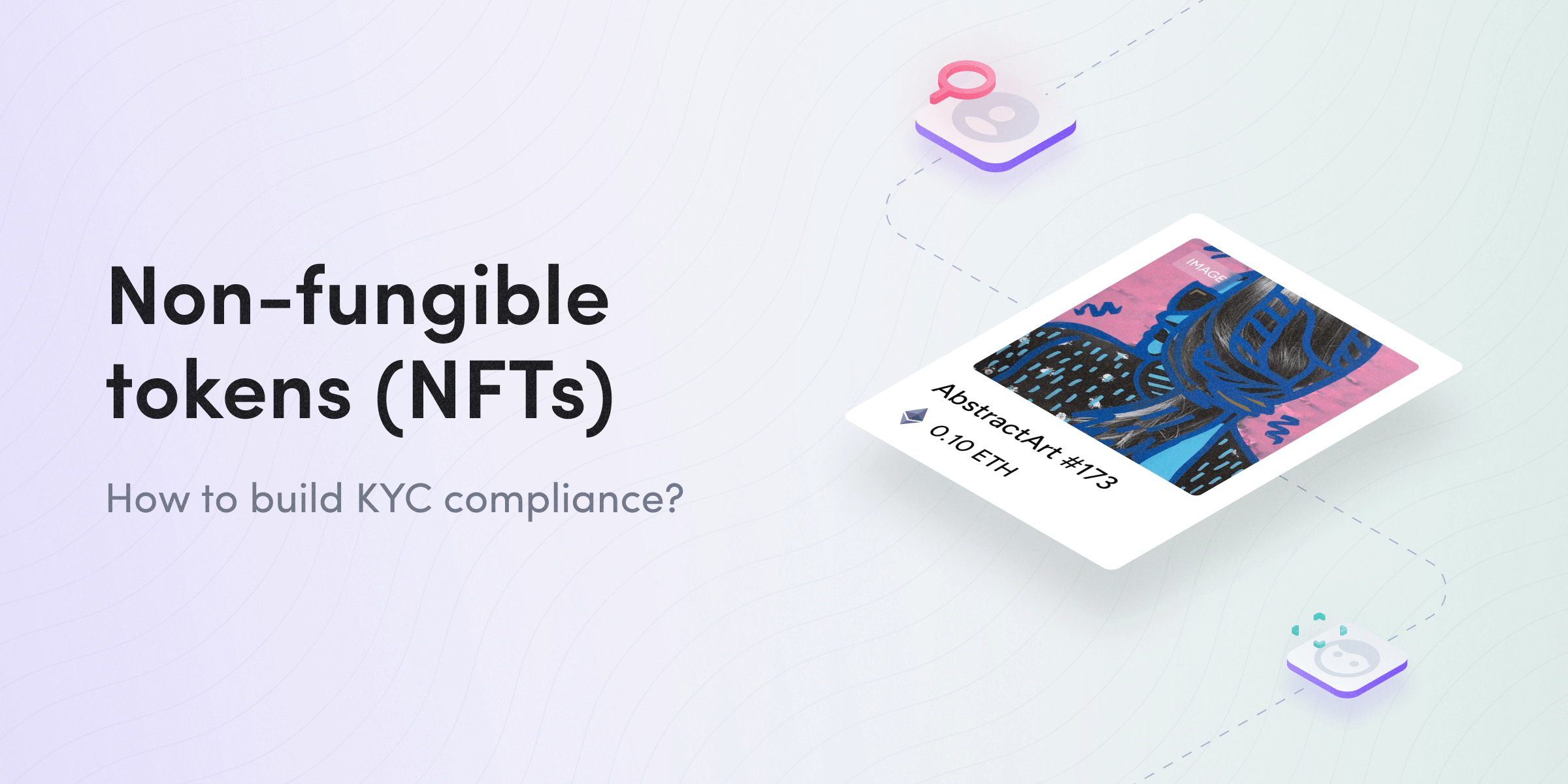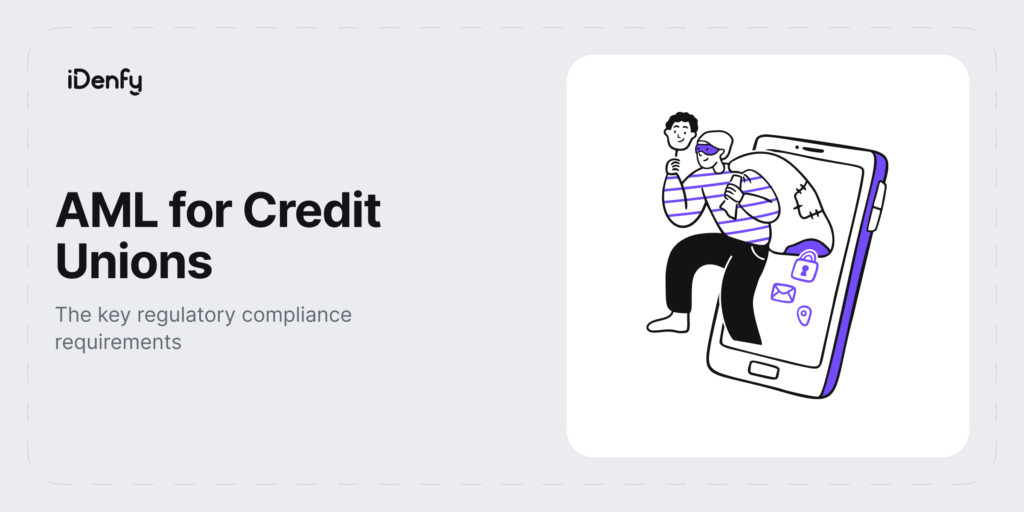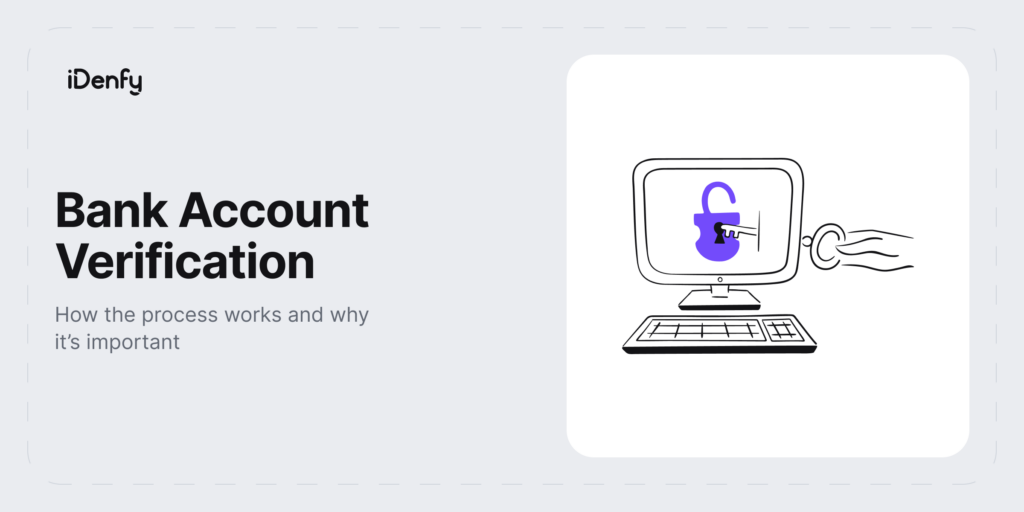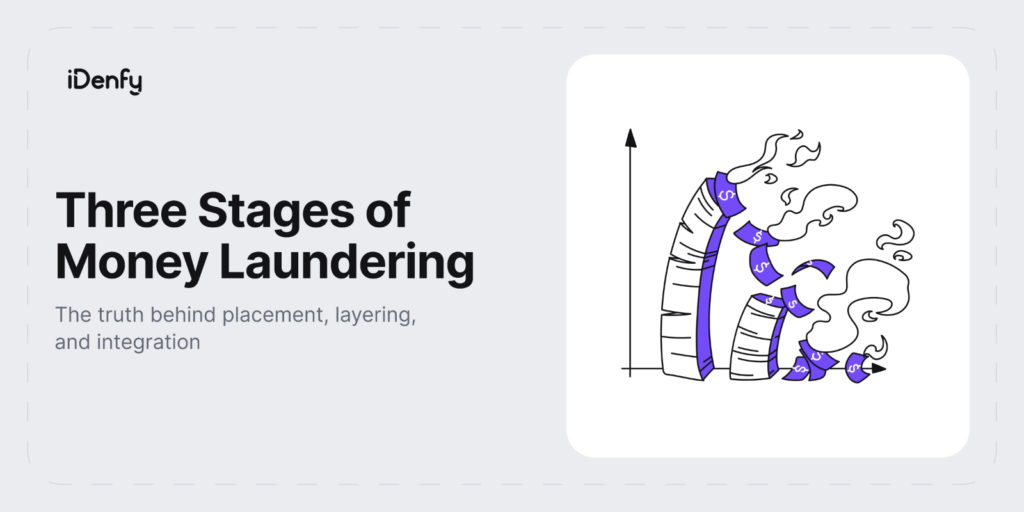In February 2022, an Opensea phishing attack made more than 17 people lose millions in NFTs. Every day, crafty fraudsters make NFTs seem unsafe for noobs, experienced investors, professional creators, and native web2 users. So, a good understanding of what NFT frauds can be, how to play safe, and an understanding of KYC must be known by all NFT enthusiasts.
What are NFTs?
Non-fungible tokens, NFTs for short, are digital collectibles with unique attributes that can be owned by one person at a time. They are digital assets that lie on the blockchain representing an underlying property.
NFTs can be anything from music files, art, gaming assets, tweets, poems, pictures, videos, gifs, memes, etc. As long as they are digital files that can be minted on a blockchain. NFTs are rare and unique. All NFTs are different from each other, they contain varying metadata that differs them. Just like how two houses of the same structure differ from each other due to location.
The use of NFTs today has gone far from just being ordinary art on the blockchain to having extensive use cases; some examples involve tickets in events, accesses into the metaverse, and tradeable collectibles in games, and they can be used for IRL properties such as houses, cars, and valuables.
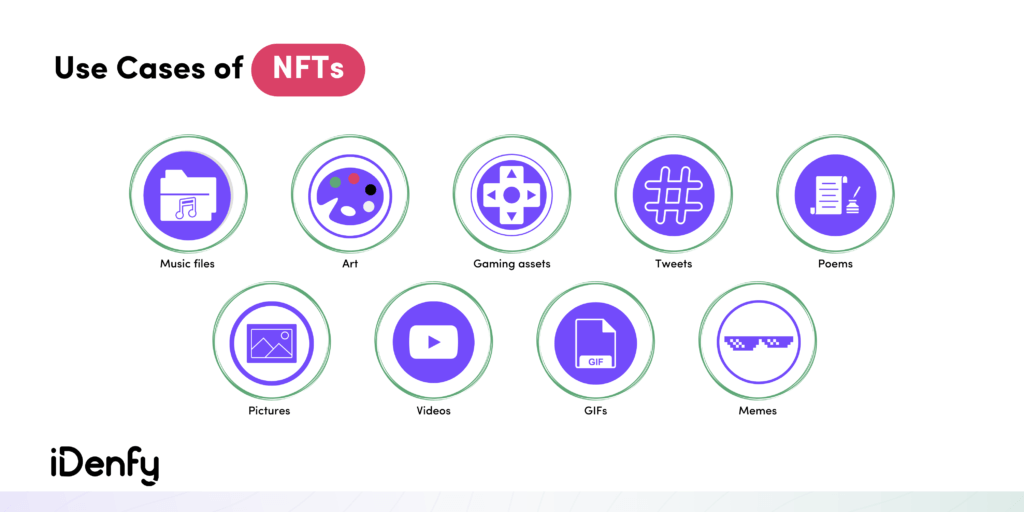
Evolution of NFTs
The year 2021 was tagged “The Year of NFTs”, Beeple’s historical sale, Facebook’s rebrand into Meta, increase in NFT as a keyword search, gaming assets, e.t.c, all led to the boom of NFTs ATH of 1785%.
While 2021 was a year for NFTs, it had been in existence before the Ethereum blockchain.
The idea of Non-fungible tokens was ignited in a paper by Meni Rosenfeld, president of the Israeli Bitcoin foundation in 2012, and was later co-authored by Yoni Assia, Vitalik Buterin, Lior Hakim, and Rotem Lev in 2013. The colored coins concept was to make cryptocurrencies perform special duties such as issuing shares by a company, giving access to events, casting a vote, e.t.c.
The concept of colored coins could not stay long, as it was limited due to the inefficiency of the Bitcoin blockchain, but it led to the invention of NFTs. Other projects, such as Quantum, came up on the Namecoin blockchain, which became the first NFT minted by Kevin McCoy.
The history narrows down to the Ethereum blockchain, an open-source system that allows developers to build smart contracts on it.
NFTs came into the mainstream in the year 2017- 2020 with projects like Cryptopunks and Cryptokitties, which brought a new definition to what NFTs are. The NFTs on the Ethereum blockchain were built following proposed token standards referred to as ERCs- Ethereum Request for Comments. The standards define the attributes of each token and their on-chain behavior.
These NFTs became the talk of the town when Cryptopunks, a 10,000 PFP NFT collection initially distributed for free, started selling for a mouth-watering price, with the lease cost being $ 1 million at the time. Cryptokitties also got a massive hit in space because of their uniqueness in monetizing in-game assets. This unique ability gave gaming a new scope of operation as other projects used the concept to develop a play-to-earn game with tradeable assets.
Why are NFT frauds rampant?
Fraudsters or scammers don’t care if they are attacking a noob or an “Idolo”, a rich wallet or a “broke” one, all they want is access to your assets.
The traffic of people who wants to own NFTs has increased since the immersive internet- Metaverse was introduced into the game. Brands building in web3 believe that the metaverse is the next big thing in the upcoming internet iteration.
Also, web3 brands are becoming token-gated, and fraudsters understand that each asset is valuable. If the investors or creators get their accounts compromised, it might lead to losing all assets in their wallets.
Another reason why NFTs are rampant is that there are many newbies in the space, people who think NFTs are just for cash-grabbing, this set of users easily fall for the trick or trap set by these scammers in other to get their hard-earned money.
The NFT space is a wide and wild terrain, it wouldn’t be safe if web3 users didn’t understand how to spot frauds in the space. Below, we shall be discussing, in full, frauds in NFTs and how to be safe while navigating in space.
Common Frauds in the NFT space
The growth of NFTs has caught the attention of everyone, the NFT space is filled with the good, the bad, and the ugly stories. Any project with no regard for the hype or the team can turn out to be a “Lambo” or a scam. An NFT project that included the likes of Dj Khaled, French Montanna, Floyd Mayweather, and some others turned out to be a rug pull after raising 20 million dollars. Let’s discuss some common frauds in the space.
Rugpull scams
This is one of the most popular scams or fraudulent acts in the space. Right from the early days of DeFi, Rugpull has always been known to elude users’ funds easily.
Rugpull scams are from the core teams of a project, mostly the creators or developers. Rugpull scams can be so real that the projects get hyped up using strategic marketing via social media, offering incentives to buy the heart of the community, fake promises, e.t.c.
The game is played when the team has amassed more than enough during mint and then dumps all by deleting media accounts, shutting off websites, and other things. A few of the projects that got the hype and turned out to be a Rugpull are Frosties-NFT, Trollz, e.t.c
Phishing Scams
Phishing scams are rampant and cunny. Most people fall into them when they don’t pay attention to details. Typically, phishing links are launched to compromise your transactions. It becomes active when you fall for it by approving transactions unknowingly.
They are fake links that can be duplicate of your wallet interface, your marketplace interface, a mail of a project you want to mint, a CTA to a fake site. In other words, they can be anything replicated to take charge of what you do.
Fake NFTs and bidding Scams
If you are a lover of creative art and you just collect NFTs because of your affinity towards it, you probably fall into the Fake NFT ditch. Some hungry scammers go to free image websites, download, and mint on the open sea.
A bidding scam occurs when a scammer bids with a certain amount and sends a lesser amount to the owner.
Ponzi Scams
These scams are highly rampant. What these guys want is your liquid, and they promise more than what is possible for the project. They are painting themselves to be the next Lambo while they don’t have a solid plan for building the project.
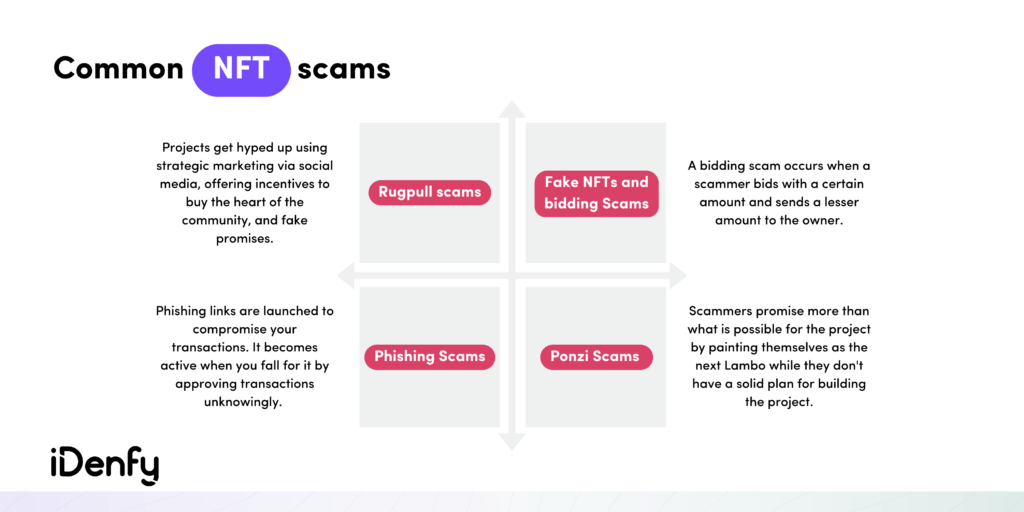
How to avoid scams in the NFT space
Many guys out there know the perfect way to deal with scams, and it should be a must-know for everyone too. Although NFT platforms are also putting in the best security measures to protect user interests, each investor must understand how to be safe.
- Do Your Research: Influencer marketing can be scams too, search the project out, check out the teams if they are doxxed (a need for KYC is evident), how experienced they are, check out their social media accounts, and how connected they are. Read the roadmaps, study whitepapers, and other essential documents. Check for their engagement and how reliable their community is.
- Never be too greedy: Do not fall for get-rich-quick actions, sweet talks, Ponzi emails, etc. Check the NFT project if it relates to you. Also, there are impersonators everywhere (again, identity verification would help). They are easy to spot because there would always lapse.
- Be vigilant and detailed: Phishing and bidding scam requires you to be observant; malicious links can be sent from anywhere, confirm the right links from their social handles or Discord communities.
- Join a genuine community: Two heads are better than one, a genuine community will help to clear any iota of doubt about the project because research would be done by a lot of people, and curated information would be gotten to make investment decisions.
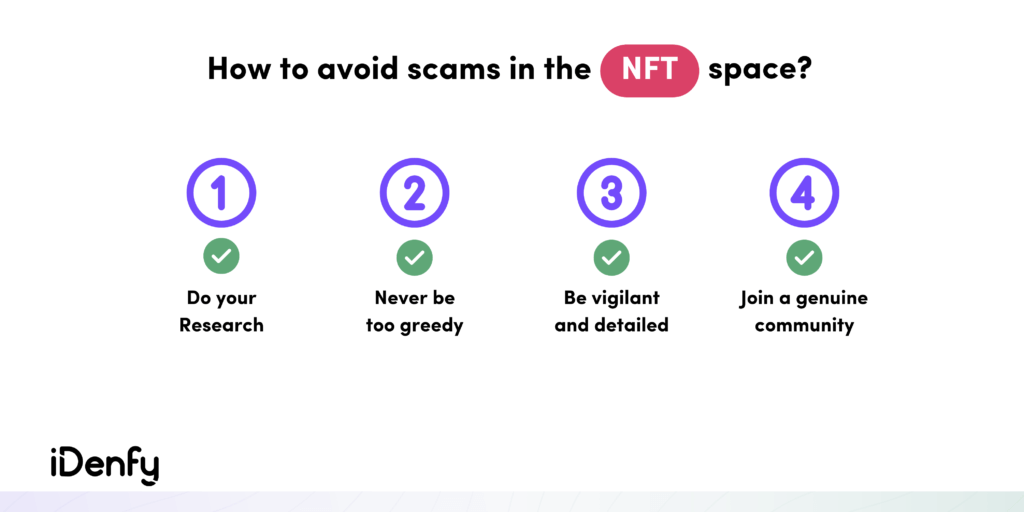
The need for KYC in the NFT space
Despite the bear market, heavy transactions are carried out daily in the NFT space. As of writing this article, Opensea’s daily volume was at $22.72M. Anyone can hide behind these large figures for fraudulent activities. For example, scammers can use money from a dubious scheme to buy cryptocurrencies to hide their identity and also add more complexity to tracking by minting expensive NFTs.
The privacyHQ recorded in a survey it took with 1008 active NFT investors who reside in the US shows that only 1 out of 10 investors has never fallen into a scam, and also, less than half of the investors feel their NFTs are secure.
While the NFT industry is known to be steadily growing, the continual rise of these fraudulent activities poses a lot of threat to its growth. This might be a discouragement to new users and loss of investors to marketplaces, so there is a need for guaranteed safety.
Identity verification is a key to avoiding or cutting the wings of fraudsters or scammers, it is a way of identifying and verifying customers to be sure of their claims. It helps to establish a trust-worthy business bond between the investors and the NFT brands.
NFT marketplaces or brands with identity verification would be considered a top priority in other to guarantee the safety of funds, trades, or any other service rendered by such brands or marketplaces.
The solution to KYC for NFT brands
NFT brands and investors can fall into the ditch of scammers and fraudsters at any time. While investors keep an open eye on the already discussed safety practices, there is a need for NFT brands to effectively onboard their customers and remember the KYC and AML requirements.
For this reason, the FATF has been making shots at virtual assets (VA) and virtual assets service providers (VASP) by giving regulations for AML and KYC requirements. While this might not be a direct shot at NFTs and NFT brands, they can nevertheless fall into this category anytime soon.
We understood the complexity of regulations and ensured that identity verification should act as a simple add-on to the existing blockchain projects. We use 3D liveness detection to tackle impersonation threats, thus eliminating the fraud probability completely.
To make developers’ work easier, they get an easy-to-use API (as well as a multitude of mobile SDKs) that is 100% compliant with GDPR, CCPA, and all other associative data laws.
Let’s make NFT collections and their owners verified! Book a free demo here.
